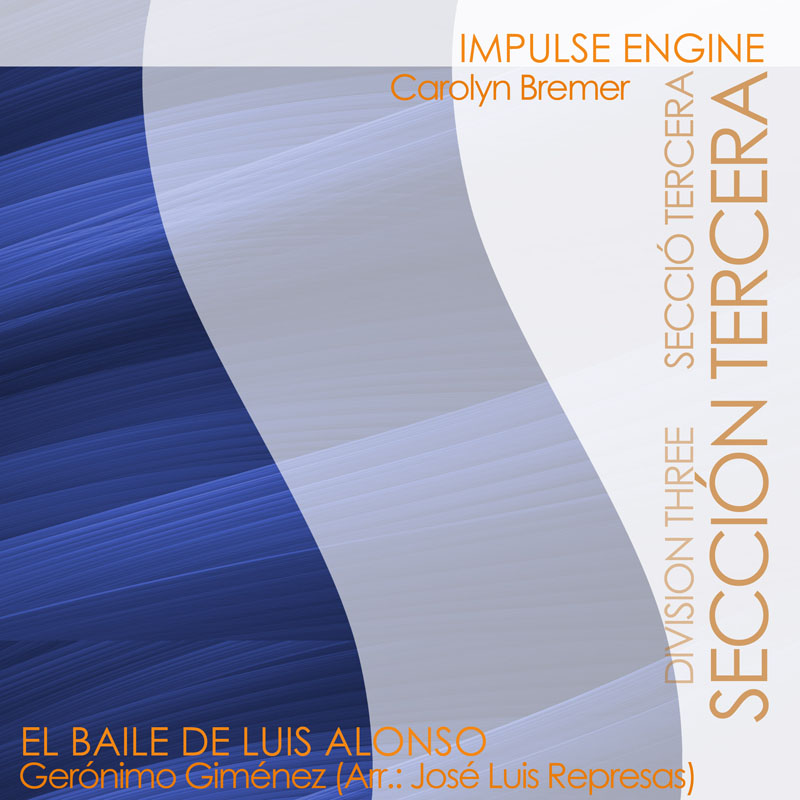The bands participating in the Division Three of the 2023 “City of Valencia” International Music Band Contest will have to interpret as compulsory pieces the score “Impulse Engine” by Carolyn Bremer and the score «El Baile de Luis Alonso – Intermedio de la zarzuela» by Gerónimo Giménez with arrangements by José Luis Represas.
BIOGRAPHY CAROLYN BREMER
Carolyn Bremer (1957-2018) was an American composer and educator. Bremer studied at the Eastman School of Music and CalArts, and received the Ph.D. in composition from the University of California Santa Barbara. She was chair of composition at the University of Oklahoma from 1991 to 2000 where she held the Sandra and Brian O’Brien Presidential Professorship. At the time of her death, Bremer was chair of the Bob Cole Conservatory of Music at the California State University, Long Beach.
She had been dubbed a composer «driven by hobgoblins of post-modernist cant.» Her catalogue contains works based on feminist symbolism (Athene), baseball (Early Light), and postmodern theory (Adventures in Hyperreality).
Bremer had performances of her works at Carnegie Hall; in Germany, Norway, and Sweden; and for the gala 150th anniversary concert at West Point. Her consortium-commissions include Symphony for Wind Band, premiered by Ray Cramer at Indiana University, and Returns of the Day, premiered by Thomas Dvorak at University of Wisconsin-Milwaukee.
Bremer was guest composer for the Technology Initiative Conference at Collin County College in Dallas, Texas; the Women Band Directors International Conference in San Diego; and composer-in-residence at Mansfield University.
COMPULSOTY PIECE: «IMPULSE ENGINE»
Impulse Engine is based on simple, motoric, fanfare-like motives that are tossed about the ensemble. This high-energy piece is based on another of Bremer’s compositions ‘Throw Caution to the Wind’ (for brass and percussion) which was commissioned for the Monarch Brass Ensemble by the Oklahoma Summer Wind Festival.
BIOGRAPHY GERÓNIMO GIMENEZ
Geronimo Gimenez Bellido (1854-1923) was born in Seville and he studied music in Cádiz furthering his studies at the Paris Conservatory. Upon his return, he settled in Madrid where he was appointed director of the orchestra of the Teatro Apolo and, shortly after, of the Teatro de la Zarzuela. His first successful zarzuela was Trafalgar, premiered in Barcelona (1890). Later, many others followed, of which we could highlight the famous twin works, El Baile de Luis Alonso (1896) and La Boda de Luis Alonso (1897), whose symphonic pages recall his ability in this field, superior to that usual in composers of the Spanish lyrical genre, and somewhat influenced by Italian music. The last years of his career were sad and the composer lived in poverty, despite some occasional successes.
COMPULSOTY PIECE: «EL BAILE DE LUIS ALONSO – INTERMEDIO DE LA ZARZUELA»
The zarzuela El Baile de Luis Alonso tells the adventures of Luis Alonso, a gypsy dance teacher, and his wife Mª Jesús. The action takes place in the city of Cádiz, around 1850. The author takes advantage of the theme of the work to resort to popular Hispanic themes.
The Intermedio uses new music, not used in any of the other numbers of the work. It is made up of three sections that use music that was popular from the period in which the action of this zarzuela takes place.

